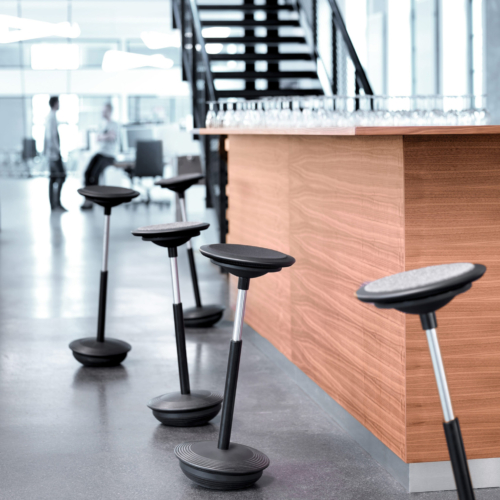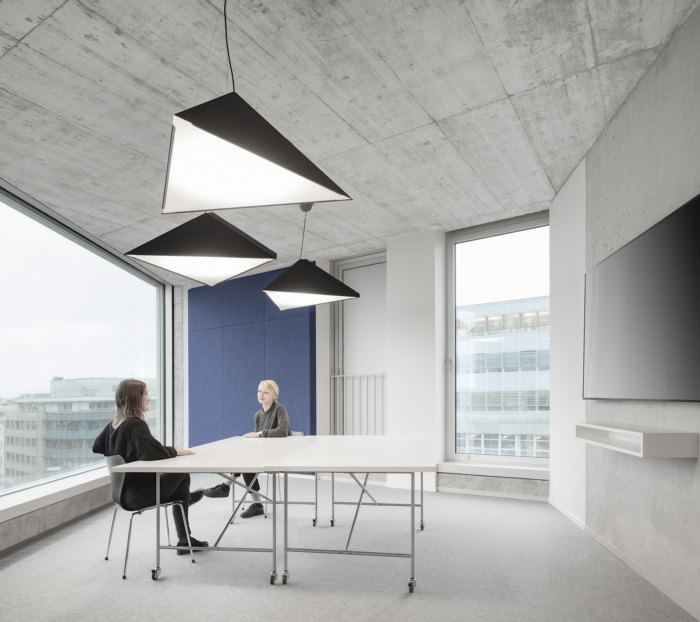
Suhrkamp Verlag Offices – Berlin
Thousands and thousands of books decorate the walls of Suhrkamp Verlag's new Berlin office, a space brought to life by the publishing house's vast collection of works.
KINZO realized the book-infused office design for publishing company, Suhrkamp Verlag, located in Berlin, Germany.
It was a long journey for Suhrkamp’s new publishing house to be move-in ready by August of 2019. Nine years earlier, the publisher relocated from Frankfurt am Main to Berlin. The next chapters of a new success story were written, part of the story being an opportunity to move into a new building in Berlin‘s historic Scheunenviertel.
Suhrkamp embarked on a search for a spatial concept that would reflect the publisher‘s identity. The project called for a tailor-made solution that would be simple and elegant while utilizing a small budget, and which, although smaller in size than the former office, would fit 135 employees.
Of course, the main protagonist of the interior was clear to the design team at Kinzo: the book. Or rather the books. Or even more aptly: the thousands and thousands of books! Our vision was a house, which rests on multi-story high stacked volumes instead of walls and columns. As emotional and atmospheric building blocks, the books should form the supporting structure and at the same time be the daily working instrument. Accordingly, shelves had to be built, many shelves – these had to fill almost every free space on the walls while simultaneously replacing them. But how could Suhrkamp’s enormous book collection find enough space on the limited wall space? A new concept for the entire building plan provided the answer: Kinzo divided the floor plan and let the walls meander through the 6 floors of the building in the form of a zigzag, like an inner facade. This idea not only created more wall space and thus sufficient shelf space, but at the same time optimized the area of the rooms and created small niches – usable for all employees as retreat rooms for spontaneous meetings, communication islands, think tanks or telephone booths.
Instead of appearing confined, the rooms convey a sense of security and concentration. The door of every editing room is designed to be flush with the shelf when opened, and to almost seem to disappear into it. This enables the room to open up into the adjacent open space of the large office and, like a natural cove, becomes its extension. The large communal area of the office acts as a counterweight to the small rooms, as well as spatially allowing colleagues to work across rooms with natural communication at eye level when the doors are opened.
All other workstations unite in the open areas, which are lined with kitchenettes and conference rooms on the angular side of the building. These are characterized by a pleasant atmosphere, and the view through the large panoramic windows directed towards the bustling Linienstraße and onto Rosa-Luxemburg-Platz. One of the conference rooms features furniture on wheels, so the room can be repurposed as required. A custom-made whiteboard, which can be opened or closed as needed, conceals a large screen. The conference rooms and kitchenettes – and thus the floors – are connected internally via the so-called “narrative staircase”, which runs from the first floor at an oblique angle to the sixth floor. The staircase received its name because of its impressive shelf, which follows the steep course of the stairs like a dramatic narrative thread. The oak shelf mirrors the materiality of the staircase steps.
The color concept of the high-quality materials and furniture is well balanced. To balance the lively colorfulness of the thousands of book spines, the chosen colors evoke the greatest possible tranquility. All fabric-covered built-in furniture is dark blue, while the loose furniture picks up on primary colors, and here and there accentuates the grey and white mottled carpet of the offices. This in turn blends harmoniously into the color scheme of the rough grey from the exposed concrete ceilings with visible formwork, the elegant white of the shelves and the minimalist grey of the balustrades and soffits. High-quality roller blinds, also in grey, round off the concept. The attentive guest (as well as the employees) will notice that the small retreats and meeting niches with their textile wallpapers pick up on the individual tile patterns of the toilets on each floor – a playful design which, however, ensures intimacy.
In the end result, Kinzo has optimized the relatively small space of the new Suhrkamp publishing house. Not only was it possible to integrate all the books and shelves into the space, but it was also possible to create a space that was both tailored to the different requirements of the users and flexible at the same time. Although high-quality materials and products were used and many fixtures had to be custom-made, the solutions remained cost-effective and within budget. Through their work, Kinzo has proven their expertise in office interior design, which has grown over the years, and at the same time opened new doors by meeting the requirements and needs of a traditional publishing house, an institution of high culture.
Design: KINZO
Photography: Sebastian Dörken, Schnepp Renou














































